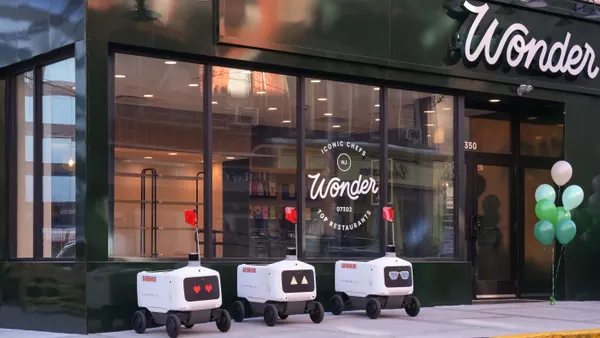Dive Brief:
- Grubhub launched a technology suite called Ultimate that is focused on takeout orders, according to a press release emailed to Restaurant Dive. The platform provides a lightweight point of sale with direct integration to Grubhub's website and app, customer displays with real-time order estimates across all channels, in-store self-ordering kiosks and a kitchen display system.
- The technology is designed for restaurants of all sizes and can be used by stadiums and food halls, allowing customers to order ahead and pick up once their orders are ready.
- Ultimate is currently available in 100 restaurants through a pilot program in New York City and Chicago. It is also available in other cities and on college campuses, including Ohio State University, where the technology was originally tested, a Grubhub spokesperson told Restaurant Dive via email.
Dive Insight:
While many restaurants have been rushing into delivery, carryout still makes up the bulk of the off-premise industry (93% according to the National Restaurant Association) and has better margins than delivery since it doesn't come with added commission rates.
Offering a technology suite focused solely in this area will help Grubhub get back to its roots: it started out as a food ordering service and didn't offer delivery until 2015. Given the negative attention Grubhub has received in New York over its past use of microsites, phone call fees and CEO's comments on the delivery industry, Grubhub needs a boost. Focusing on pickup makes a lot of sense. It could allow the company to work with more restaurants that are reticent to offer delivery and want to focus on other technologies, especially since this product suite is customizable.
This new product could be a differentiator among competitors as well. While Uber Eats offers a pickup and dine-in option and Postmates has been playing in the order ahead space for event venues, other third-party marketplaces don't really have a product suite solely focused on carryout while also integrating with delivery technology. This functionality allows drivers to have a better understanding of when an order is ready.
For restaurants, the technology will allow independents and small chains to use integrated technology without having to work with multiple vendors, a growing demand among restaurants, especially since the costs add up. The self-order kiosk function will help workers focus on tasks beyond taking orders, which could help increase efficiencies and improve the overall customer experience. It will also allow restaurants to be more competitive with their large chain counterparts, like McDonald's, Burger King, KFC, Shake Shack, Panera and Wendy's, many of which have been boosting investments in mobile apps, self-order kiosks and/or digital queues.
"If [a restaurant] is attempting to tap into getting above industry average growth, then the integration of technology becomes much more important," Hudson Riehle, SVP of the research and knowledge group at the National Restaurant Association, told Restaurant Dive.











